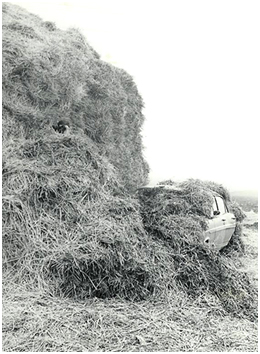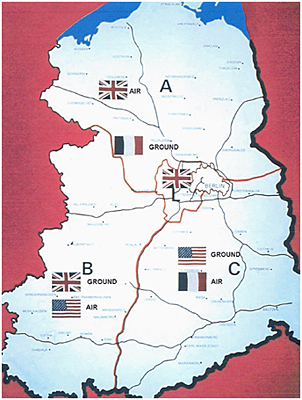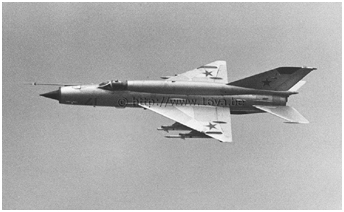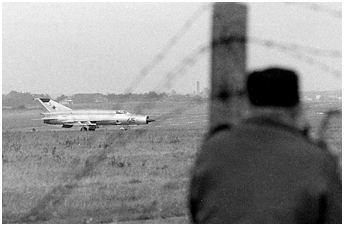
 Bill Burhans served as a tour officer with the USMLM Air Team from July 1971 to June 1975. He returned in 1979 to command Detachment 16,
7113th Special Activities Squadron (the Air Team), departing in early spring 1980 following a December 1979 Soviet-originated nasty incident.
He recalls for us one of his first missions at Merseburg Soviet Airfield.
Bill Burhans served as a tour officer with the USMLM Air Team from July 1971 to June 1975. He returned in 1979 to command Detachment 16,
7113th Special Activities Squadron (the Air Team), departing in early spring 1980 following a December 1979 Soviet-originated nasty incident.
He recalls for us one of his first missions at Merseburg Soviet Airfield.
 Autre lieu, mais même tactique : un équipage de la USMLM se dissimule derrière un tas de foin.
© USMLM.
Autre lieu, mais même tactique : un équipage de la USMLM se dissimule derrière un tas de foin.
© USMLM.
A different place, but the same tactic. Another USMLM crew takes cover behind a haystack. © USMLM.
 La RDA était divisée en trois zones désignées A, B et C que se partageaient à tour de rôle les équipes air et terre de chaque Mission alliée.
L'équipe air de la USMLM partageait toujours la zone qui lui était assignée avec une équipe terrestre de BRIXMIS.
Le "Local" était également assuré par une équipe terre de manière alternée à Berlin-Est et ses alentours. © DR.
La RDA était divisée en trois zones désignées A, B et C que se partageaient à tour de rôle les équipes air et terre de chaque Mission alliée.
L'équipe air de la USMLM partageait toujours la zone qui lui était assignée avec une équipe terrestre de BRIXMIS.
Le "Local" était également assuré par une équipe terre de manière alternée à Berlin-Est et ses alentours. © DR.
The GDR was divided into three areas designated A, B and C, which were shared in turn by the ground and air teams of each
Allied mission. The USMLM Air Team always shared the assigned area with the BRIXMIS Ground Team. The "Local" around and outside East Berlin also was shared in turn by
an Allied ground team. © DR.
I cannot speak for anyone else, but I know that the month I functioned as a back-seater was time very well spent. I could observe two real professionals - Lynn Hansen
and Nick Netter - in action, "up close and personal."
I recall a very lovely August 1971 day in Area B during which time we were tasked to monitor flying activity at Merseburg Soviet Airfield. If I am not mistaken,
this took place a week after my adventures at Allstedt described earlier (see > "My First Back-Seat Tour").
The 85th Guards Fighter Aviation Regiment equipped with the humpbacked MiG-21SMT "Fishbed-K" fighter interceptor was stationed at Merseburg and our task was to cover
flying activity there. We had succeeded in reaching the airfield area without attracting attention so we did not see any hostile surveillance elements. One of the
favorite Observation Post (OP) at this airfield was at the top of a rather steep hill. We used this location as our pre-OP and waited for the action to begin. Aircraft were taking
off toward us, which was not optimum for us, so Lynn decided to move to an OP closer to the end of the runway.
There was a huge open field off the southwest end of the runway and an enormous haystack stood in the middle of this expanse. This allowed us to cover the car
completely, hide ourselves in the hay and observe everything going on around us. Visibility was excellent and we awaited further activity.

 However, nothing much happened for a long time, although we did notice quite a few high-altitude contrails overhead.
Our guess was that some sort of exercise was underway and the aircraft may well have deployed to another area.
At last we noticed aircraft in the distance on their landing approach to Merseburg. It appeared that this would be the end of the activity and, if we wanted to get
any coverage of the aircraft at all, we would have to get a lot closer to the runway. This we did.
I do not know if Lynn knew beforehand that there was a large hole in the first airfield perimeter fence, but there it was. The ground was dry and very hard so Nick
drove the car through the fence onto the airfield itself. He turned the vehicle and positioned it for a rapid escape should the need arise. Meanwhile, Lynn and I began
to photograph the aircraft through the second perimeter fence as they ended their landing roll and turned left onto the taxiway en route to the flightline. The
sun was in a perfect position and highlighted the dielectric patch on the tip of the vertical stabilizer and on the ventral fin under the tail. I remember clearly the bright
green paint on these patches!
What we saw looked exactly like what I saw during the regimental flush at Altenburg (see > "Altenburg Squadron "Flush")
, except we were much closer to the taxiing aircraft. There really was not a great deal of
intelligence value in the photography we obtained at Merseburg. Plus, it would have been difficult to explain how we were able to get that close to a taxiing aircraft, although
use of the 1000-mm lens probably would have provided sufficient plausible deniability. The main lesson I learned during this event was how important it was to know your target
area well and to strive to get to your target without attracting undue attention and the resultant stultifying surveillance.
However, nothing much happened for a long time, although we did notice quite a few high-altitude contrails overhead.
Our guess was that some sort of exercise was underway and the aircraft may well have deployed to another area.
At last we noticed aircraft in the distance on their landing approach to Merseburg. It appeared that this would be the end of the activity and, if we wanted to get
any coverage of the aircraft at all, we would have to get a lot closer to the runway. This we did.
I do not know if Lynn knew beforehand that there was a large hole in the first airfield perimeter fence, but there it was. The ground was dry and very hard so Nick
drove the car through the fence onto the airfield itself. He turned the vehicle and positioned it for a rapid escape should the need arise. Meanwhile, Lynn and I began
to photograph the aircraft through the second perimeter fence as they ended their landing roll and turned left onto the taxiway en route to the flightline. The
sun was in a perfect position and highlighted the dielectric patch on the tip of the vertical stabilizer and on the ventral fin under the tail. I remember clearly the bright
green paint on these patches!
What we saw looked exactly like what I saw during the regimental flush at Altenburg (see > "Altenburg Squadron "Flush")
, except we were much closer to the taxiing aircraft. There really was not a great deal of
intelligence value in the photography we obtained at Merseburg. Plus, it would have been difficult to explain how we were able to get that close to a taxiing aircraft, although
use of the 1000-mm lens probably would have provided sufficient plausible deniability. The main lesson I learned during this event was how important it was to know your target
area well and to strive to get to your target without attracting undue attention and the resultant stultifying surveillance.
 |
Plan du site - Sitemap |  |
